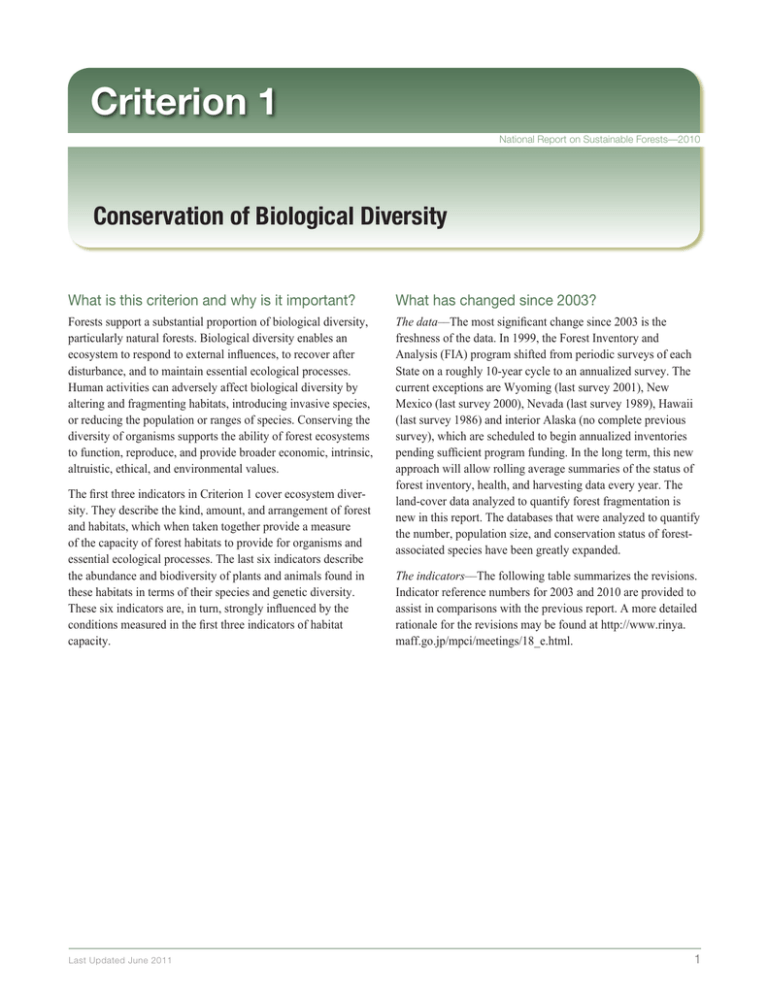Criterion 1 Conservation of Biological Diversity What has changed since 2003?
advertisement

Criterion 1 National Report on Sustainable Forests—2010 Conservation of Biological Diversity What is this criterion and why is it important? What has changed since 2003? Forests support a substantial proportion of biological diversity, particularly natural forests. Biological diversity enables an ecosystem to respond to external influences, to recover after disturbance, and to maintain essential ecological processes. Human activities can adversely affect biological diversity by altering and fragmenting habitats, introducing invasive species, or reducing the population or ranges of species. Conserving the diversity of organisms supports the ability of forest ecosystems to function, reproduce, and provide broader economic, intrinsic, altruistic, ethical, and environmental values. The data––The most significant change since 2003 is the freshness of the data. In 1999, the Forest Inventory and Analysis (FIA) program shifted from periodic surveys of each State on a roughly 10-year cycle to an annualized survey. The current exceptions are Wyoming (last survey 2001), New Mexico (last survey 2000), Nevada (last survey 1989), Hawaii (last survey 1986) and interior Alaska (no complete previous survey), which are scheduled to begin annualized inventories pending sufficient program funding. In the long term, this new approach will allow rolling average summaries of the status of forest inventory, health, and harvesting data every year. The land-cover data analyzed to quantify forest fragmentation is new in this report. The databases that were analyzed to quantify the number, population size, and conservation status of forestassociated species have been greatly expanded. The first three indicators in Criterion 1 cover ecosystem diversity. They describe the kind, amount, and arrangement of forest and habitats, which when taken together provide a measure of the capacity of forest habitats to provide for organisms and essential ecological processes. The last six indicators describe the abundance and biodiversity of plants and animals found in these habitats in terms of their species and genetic diversity. These six indicators are, in turn, strongly influenced by the conditions measured in the first three indicators of habitat capacity. Last Updated June 2011 The indicators––The following table summarizes the revisions. Indicator reference numbers for 2003 and 2010 are provided to assist in comparisons with the previous report. A more detailed rationale for the revisions may be found at http://www.rinya. maff.go.jp/mpci/meetings/18_e.html. 1 National Report on Sustainable Forests—2010 Criterion 1. Conservation of Biological Diversity. 2003 Reference 2003 Indicator Revision Action 2010 Reference 2010 Indicator Ecosystem Diversity 1 Extent of area by forest type relative to total forest area Merge 2003 Indicators 1 and 2 1.01 Area and percent of forest by forest ecosystem type, successional stage, age class, and forest ownership or tenure 2 Extent of area by forest type and by age class or successional stage Merge 2003 Indicators 1 and 2 3 Extent of area by forest type in protected area categories as defined by IUCN (International Union for Conservation of Nature) or other classification systems Merge 2003 Indicators 3 and 4 1.02 Area and percent of forest in protected areas by forest ecosystem type, and by age class or successional stage 4 Extent of areas by forest type in protected areas defined by age class or successional stage Merge 2003 Indicators 3 and 4 5 Fragmentation of forest types Change “forest types” to “forests” 1.03 Fragmentation of forests Species Diversity 6 The number of forest-dependent species Change “forest-dependent” to “native forest associated” 1.04 Number of native forest-associated species 7 The status (threatened, rare, vulnerable, endangered or extinct) of forest-dependent species at risk of not maintaining viable breeding populations, as determined by legislation or scientific assessment Change “forest-dependent” to “native forest associated” and delete “at risk of not maintaining viable breeding populations” 1.05 Number and status of native forestassociated species at risk, as determined by legislation or scientific assessment NEW 1.06 Status of onsite and offsite efforts focused on conservation of species diversity Genetic Diversity 8 Number of forest-dependent species that Change “forest-dependent” to “native forest occupy a small portion of their former range associated” and reword 1.07 Number and geographic distribution of forestassociated species at risk of losing genetic variation and locally adapted genotypes 9 Population levels of representative species Add “ forest associated” and reword from diverse habitats monitored across their range 1.08 Population levels of selected representative forest-associated species to describe genetic diversity 1.09 Status of onsite and offsite efforts focused on conservation of genetic diversity NEW Last Updated June 2011 2
